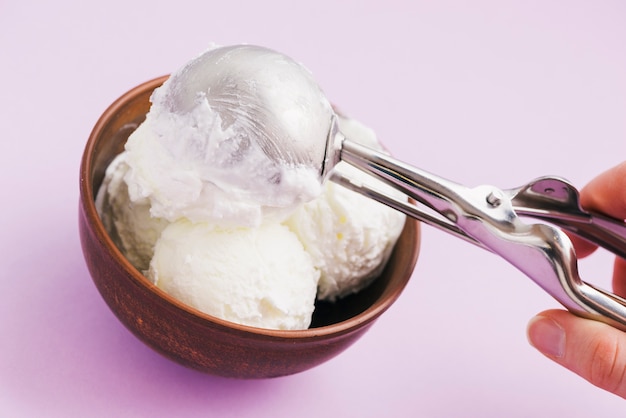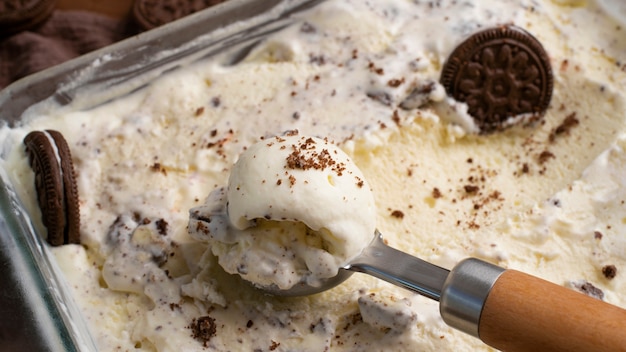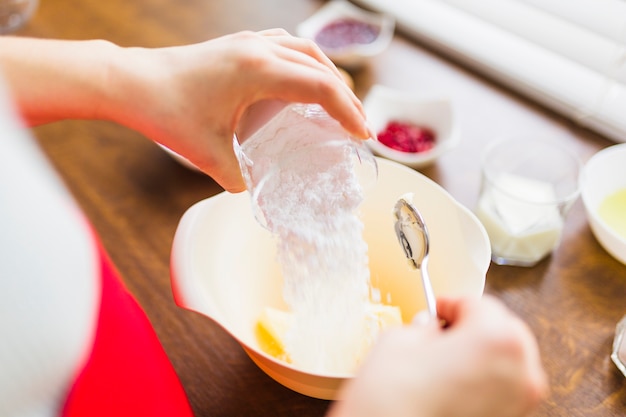Fried ice cream. Just the name conjures up images of a sweet, crispy treat, a delicious paradox of hot and cold, crunchy and creamy. It's a dessert that always gets people talking, but I'll admit, I used to be intimidated by it. How on earth do you fry something as delicate as ice cream without it turning into a gooey mess? The answer, my friends, is all in the technique! After a few trial-and-error attempts (and a couple of melted disasters), I've finally cracked the code for perfect fried ice cream. And let me tell you, it's a game-changer.
This guide is for everyone out there who's ever been hesitant to try fried ice cream, or who's had a less-than-stellar experience in the past. I'm going to break down each step, from selecting the right ice cream to mastering the art of frying, so you can confidently create a crispy, delicious masterpiece at home. Believe me, once you've nailed this, it'll become one of your go-to dessert tricks!
(Part 1) The Ice Cream: Picking the Perfect Base

The foundation of any good fried ice cream is the ice cream itself. It's not a one-size-fits-all situation. You can't just grab any old pint from the freezer and expect it to work. Think about it: you're going to be scooping it, coating it, and then frying it – it's gotta be able to hold its shape and resist melting under pressure.
The Best Ice Cream Choices:
- Premium Vanilla: This is the classic choice for a reason. It's a blank canvas that beautifully absorbs the flavours of the coating. I always look for a high-quality vanilla with real vanilla bean specks, it makes a noticeable difference.
- Chocolate: A fantastic alternative to vanilla. The rich chocolate flavour provides a wonderful contrast to the crispy exterior.
- Coffee: If you're looking to add a touch of boldness, coffee ice cream is an excellent choice. The coffee flavour gets amplified by the frying process, adding an extra layer of depth.
- Cookie Dough: This is a crowd-pleaser, especially for kids. Just make sure the chunks of cookie dough are small enough to be manageable when you're shaping and coating the ice cream.
I've tried using other flavours like strawberry and mint, but they tend to get too runny when fried. And remember, if you're feeling adventurous, you can always add mix-ins like chocolate chips, chopped nuts, or even crumbled Oreos. But keep it balanced, you don't want the mix-ins to overwhelm the flavour of the ice cream.
(Part 2) Prepping the Ice Cream for Frying

Right, so you've got your ice cream. Now, the real key is to ensure your ice cream is as firm as possible before you start scooping. This is crucial for preventing melting and making sure your fried ice cream holds its shape, looking beautiful and not turning into a puddle.
Freezing the Ice Cream:
- Freezing Time: Ideally, you want to freeze your ice cream for at least 4 hours, and even better, overnight. This gives it the best chance to become rock-solid and reduces the risk of melting during the frying process.
- Freezing Method: To prevent freezer burn (which can make the ice cream icy and unpleasant), freeze your ice cream in a container with a lid.
Scooping Out the Ice Cream:
- Scooping Technique: Use a small cookie scoop or a melon baller for a nice, uniform shape. It's much easier to handle and fry when it's consistent in size and shape.
- Freezing the Scoops: Once you've scooped out your ice cream, give it another 15-20 minutes in the freezer. This helps them firm up even more and ensures they keep their shape when you're coating them.
It might seem like a lot of steps, but trust me, it's all about getting it right! The extra freezing time will make all the difference, you'll have a beautiful, crispy fried ice cream that doesn't melt into a puddle.
(Part 3) The Coating: Creating a Crunchy Shell

Now, the moment you've been waiting for: the coating! This is where we transform a simple scoop of ice cream into something extraordinary. The secret is to choose the right ingredients and layer them to create a crispy, flavourful shell that both protects the ice cream and adds a delicious textural element.
The Coating Layers:
- First Layer: This is the foundation, and it needs to be something that will firmly stick to the ice cream. Think about a light batter – a simple pancake batter, a thin layer of egg wash, or even a bit of cornstarch mixed with water. This layer forms the base for the other coatings.
- Second Layer: Here's where you get creative. This layer is all about adding flavour and crunch. The options are plentiful: crumbled cookies, crushed nuts, toasted breadcrumbs, even cereal flakes. Get those taste buds going!
- Third Layer: The final touch is a sprinkle of sugar or powdered sugar. This adds a little extra sweetness and gives your fried ice cream a beautiful dusting of white.
It's not mandatory to use all three layers. You can absolutely achieve a delicious result with just a simple batter and a coating of your favourite crunchy ingredient. But if you want to go all out, layer away! And remember, don't be afraid to experiment. Try different combinations and see what you come up with!
(Part 4) Frying Technique: The Key to Success
Let's talk about the moment of truth: the frying. It's where we see that glorious transformation come to life, but it's not as scary as it sounds. Just follow my tips, and you'll be on your way to crispy, golden-brown perfection.
The Frying Oil:
- Choosing the Oil: You want a neutral-tasting oil with a high smoke point, like vegetable oil or canola oil. These oils can withstand the high temperatures needed for frying without burning or imparting an off-flavor.
- Oil Temperature: The ideal temperature for frying ice cream is around 350°F (175°C). To test if your oil is hot enough, drop a small piece of bread into it. If it sizzles and browns quickly, you're good to go.
Frying the Ice Cream:
- Gentle Entry: Carefully slide the coated ice cream into the hot oil. Don't overcrowd the pan, give each scoop space to fry evenly.
- Golden Brown Perfection: Cook each scoop for 1-2 minutes per side, or until golden brown and crispy. Be careful not to overcook, as this can make the ice cream melt too much.
- Draining the Excess Oil: Once the ice cream is cooked, gently remove it from the oil with a slotted spoon and let it drain on a wire rack lined with paper towels. This will absorb any excess oil.
The secret is patience and working in batches. Ensure your oil stays hot enough throughout the process, and don't be afraid to use a timer to keep track of the cooking time and prevent overcooking.
(Part 5) Serving the Fried Ice Cream
We've reached the grand finale: serving up your crispy, delicious creation. Now it's time to get creative and present your fried ice cream in a way that will make everyone swoon.
Serving Suggestions:
- Classic Sundae: A scoop of fried ice cream nestled in a bowl of warm, gooey chocolate sauce, topped with whipped cream and a sprinkle of cherries. It's a classic for a reason.
- Fruit Compote: A refreshing twist on the traditional sundae. Serve your fried ice cream with a dollop of fresh fruit compote, made with berries, peaches, or even mango. It adds a beautiful burst of flavour and colour.
- Nutty Delight: Embrace the crunch factor with a serving of fried ice cream topped with a generous sprinkle of toasted nuts, like pecans or almonds. It adds a lovely textural contrast and nutty flavour.
- Decadent Chocolate: For a truly luxurious experience, drizzle your fried ice cream with a rich chocolate ganache. It will melt beautifully over the hot ice cream and create a delicious, decadent sauce.
Don't be afraid to get creative with your serving vessels. Try using a waffle cone, a stemmed glass, or even a small metal dish. The possibilities are endless!
(Part 6) Tips for Success
Let's dive into some practical tips and tricks to avoid common pitfalls and ensure your fried ice cream turns out perfect every time.
Tips for a Perfect Fried Ice Cream:
- Don't Overfill the Scoop: When scooping out the ice cream, don't overfill the scoop. This helps ensure the ice cream cooks evenly and doesn't melt too much.
- Don't Overcook: Keep a close eye on your fried ice cream while it's cooking. Overcooking can lead to melting and a greasy texture.
- Use a Thermometer: A deep-fry thermometer is a valuable tool. It helps you maintain the correct oil temperature, crucial for successful frying.
- Work in Batches: Don't overcrowd the pan when frying. This prevents the oil temperature from dropping too much, which can affect the cooking process.
- Experiment with Flavors: Don't be afraid to get creative with your coatings and toppings. There are so many possibilities for delicious combinations!
And one more thing: if you're making a large batch of fried ice cream for a party or gathering, consider making the ice cream scoops ahead of time and freezing them. This makes the frying process much faster and easier.
(Part 7) The History of Fried Ice Cream
You might be wondering, "How did this crazy dessert even come to be?" Well, it's got a fascinating history and a story worth telling.
Origins and Evolution:
- Early Origins: The origins of fried ice cream can be traced back to Japan, where a similar dessert called "Agemanjū" was enjoyed as early as the 16th century. This traditional dessert involved deep-frying a ball of mochi filled with red bean paste.
- Migration to America: The idea of deep-frying ice cream is thought to have arrived in the United States sometime in the early 20th century, likely brought over by Japanese immigrants.
- Popularity Boom: Fried ice cream gained massive popularity in the United States during the 1970s and 1980s. It became a staple dessert in many American restaurants, especially those specializing in Chinese and Japanese cuisine.
Since then, fried ice cream has evolved and taken on many different forms. You can find it everywhere from fancy restaurants to street food stalls. It remains a popular choice for people seeking a sweet treat with a little bit of a kick.
(Part 8) Fried Ice Cream Variations
We've all heard of the classic fried ice cream, but did you know there are tons of variations out there? Here are a few to get your creative juices flowing.
Interesting Variations:
- Fried Ice Cream Sandwiches: Instead of serving a single scoop, try making a fried ice cream sandwich by placing two scoops of fried ice cream between two cookies or waffles.
- Deep-Fried Mochi Ice Cream: This Japanese dessert involves wrapping ice cream in mochi dough and then deep-frying it until crispy. It's a delicious and unique way to enjoy fried ice cream.
- Ice Cream Fritters: Take the classic donut and give it a sweet, cold twist. Simply deep-fry a small ball of ice cream dough in a batter, then serve it hot with a scoop of ice cream inside.
You can also find fried ice cream in various flavour combinations. Think about green tea, mango, or even pumpkin spice. The possibilities are endless!
(Part 9) The Science Behind Fried Ice Cream
The magic of fried ice cream is that it manages to be crispy on the outside while remaining cold and creamy on the inside. Let's break down the science behind this delightful paradox.
The Science Explained:
| Factor | Explanation |
|---|---|
| Freezing | Freezing the ice cream makes it firm and solid, allowing it to hold its shape while being coated and fried. |
| Coating | The coating acts as a protective layer, preventing the ice cream from melting too quickly in the hot oil. It also creates a crispy shell. |
| High Heat | The hot oil cooks the coating quickly, creating a crispy exterior. |
| Rapid Cooling | Once removed from the oil, the fried ice cream cools quickly, preventing the ice cream from melting completely. |
It's a beautiful balance of timing and temperature control. The key is to fry the ice cream quickly enough to create a crispy shell before it has a chance to melt completely.
(Part 10) FAQs: Answering Your Questions
Let's address those common questions that pop up when you're trying something new and exciting like fried ice cream.
FAQs about Fried Ice Cream:
- Q: Can I use any kind of ice cream?
A: It's best to use a premium ice cream that's firm and not too runny. This will help it hold its shape during frying. Avoid using ice cream that's too soft or has a lot of mix-ins, as it may melt too quickly.
- Q: What if my ice cream melts while frying?
A: If your ice cream is melting too quickly, it may be because the oil is not hot enough, or you are cooking the ice cream for too long. Check your oil temperature with a thermometer, and reduce the cooking time if necessary.
- Q: Can I use a different coating?
A: Absolutely! Experiment with different coatings, like crushed nuts, cereal flakes, or even chocolate sprinkles. You can also add flavourings to the batter, like vanilla extract, cinnamon, or cocoa powder.
- Q: How long does fried ice cream last?
A: Unfortunately, fried ice cream is best enjoyed fresh. Once it's cooked, it will start to soften and lose its crispy texture. It can be stored in the freezer for up to 24 hours, but it's not as good as freshly fried ice cream.
- Q: What are some good toppings for fried ice cream?
A: There are endless possibilities! Some popular toppings include chocolate sauce, whipped cream, cherries, nuts, and fruit compotes. Get creative and see what you come up with.
There you have it, folks. A complete guide to the world of fried ice cream, from the history and science behind it to practical tips and variations. Now you're equipped to impress your friends and family with your crispy, delicious fried ice cream skills. Go on, get out there and give it a go!
Everyone is watching

How to Cook Frozen Lobster Tails Perfectly: A Step-by-Step Guide
RecipesLobster. Just the word conjures up images of lavish meals, special occasions, and a taste of luxury. But let's...

Pigs in a Blanket Cooking Time: How Long to Bake for Perfect Results
RecipesAh, pigs in a blanket. Just the name conjures up images of those delightful little parcels of crispy pastry en...

Pork Fillet Cooking Time: How Long to Cook It Perfectly
RecipesPork fillet, or tenderloin as it's sometimes called, is a real favourite in our house. It's so versatile, and...

The Ultimate Guide to Cooking Sweet Potatoes: From Roasting to Mashing
RecipesSweet potatoes. Just the name conjures up images of warm, comforting dishes, bursts of vibrant color, and a to...

The Ultimate Guide to Tender, Juicy Pulled Pork
RecipesRight, let's talk pulled pork. It's one of those dishes that just screams "comfort food," doesn't it? I mean...
